As 2020 draws to a close, Wine Lister has compiled a report celebrating the top-performing wines and producers within a series of categories over the past year. Using our axes of Quality, Brand, and Economics, and the several factors that constitute these values, we have created seven leagues that paint a panoramic view of some of the world’s best wines, ranked within their areas of excellence.
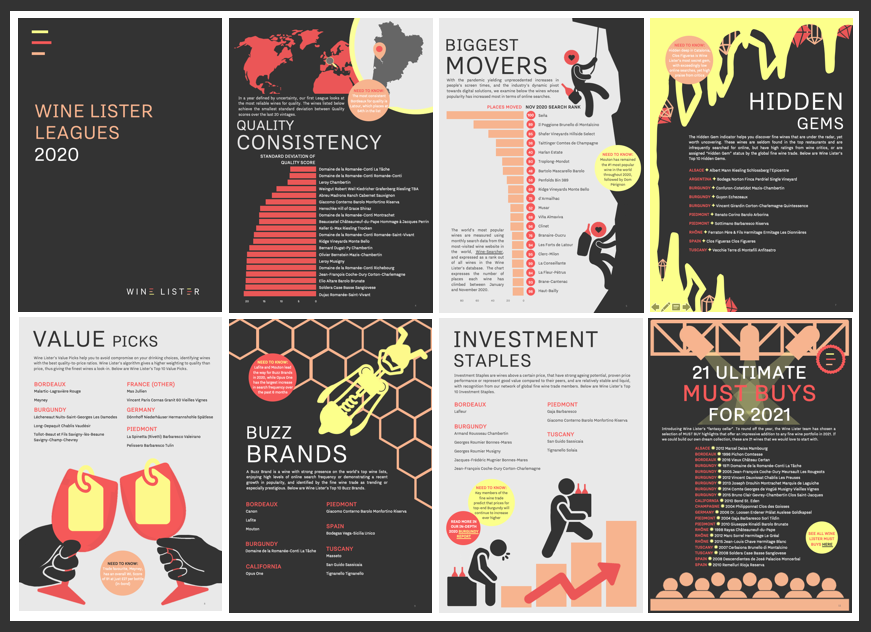
Wine Lister’s 2020 Leagues include rankings of Quality Consistency (wines that show the smallest standard deviation between Quality scores over the last 20 vintages), and Biggest Movers (wines whose popularity has increased most in terms of online searches over the past year). Our team has also put together its top-10 wines per Wine Lister Indicator, revealing our recommendations for Hidden Gems, Value Picks, Buzz Brands, and Investment Staples.
We end the Leagues with a list of 21 Ultimate MUST BUYs for 2021, compiling a selection of MUST BUY highlights hand-picked by our fine wine experts, that offer an impressive addition to any fine wine portfolio in 2021. These are some of the picks that would feature in Wine Lister’s “fantasy cellar”.
Download your free copy of Wine Lister’s 2020 Leagues here.
Burgundy prices continue to rise, and top wines are becoming ever-harder to access – but must what goes up really come down?
Wine Lister has published its second in-depth Burgundy report, with contribution from partner critic and leading Burgundy expert, Jasper Morris. With insights from key fine wine trade players from across the globe, the report investigates the state of Burgundy compared to other major fine wine regions, and discusses projections for its future performance.
Please see our key findings below:
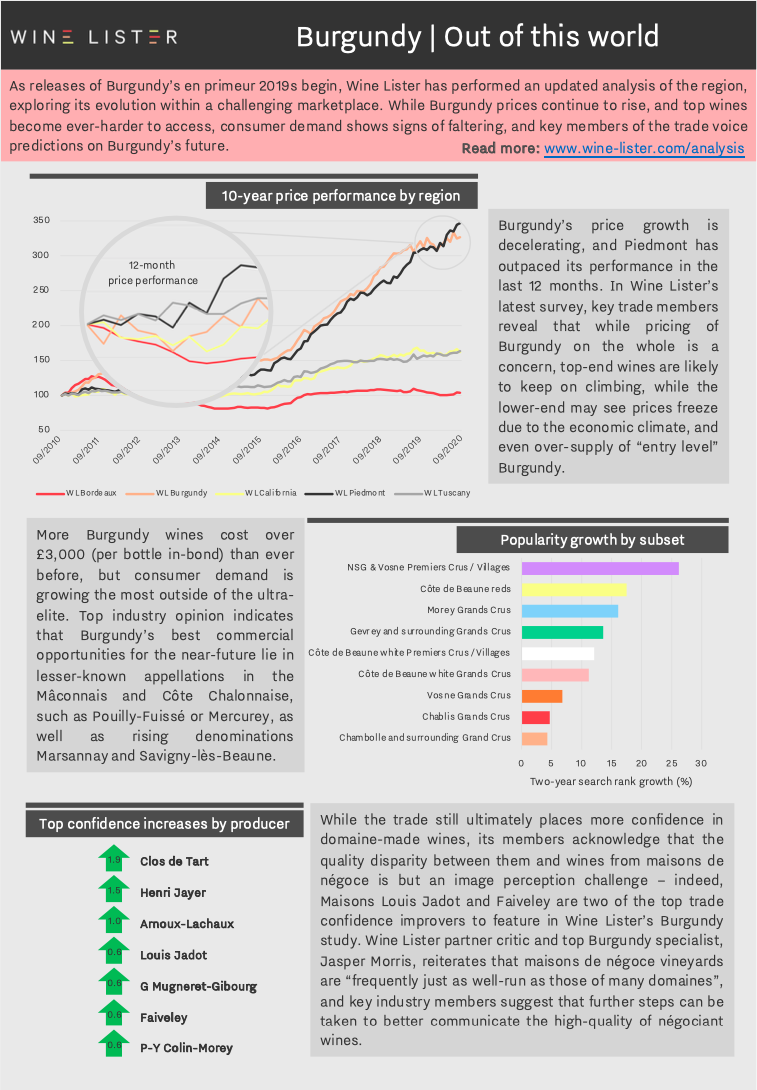
You can download the study digest in English here: Wine Lister Burgundy Study Digest 2020 or French here: Wine Lister Étude Bourgogne 2020 – Résultats Clés. The full report can be purchased on our Analysis page, while Pro subscribers can access their free copy here.
“Finché c’è vino c’è speranza” – As long as there is wine, there is hope.
Never before have Italian winegrowers been able to dedicate as much time to the care of their vineyards as in 2020. The Consorzio Vino Chianti Classico and several further Tuscan producers cite this silver lining to Covid restrictions, and they suspect it will reveal itself in the wine to come. In a year that has caused tribulation across the world, news of Italy’s promising 2020 harvest is certainly welcomed. Wine Lister has spoken to several Italian estates, which reportedly yielded high-quality grapes across the board. While regions – Piedmont and Tuscany – had their respective weather nuances, the general consensus suggests that growing season conditions were balanced, with no mention of hail or storms.
In Montalcino, the Mastrojanni team explained that lockdown prompted improved vineyard inspection in 2020: “[people] couldn’t work indoors in their offices, so the vines received the utmost attention”. They report a “very good harvest” this year, comparing it to the high-scoring 2013. Despite two short heatwaves in July and August, the estate had a mild summer overall, thanks to cooling winds that flow through the Amiata Valley in which its vineyards are situated.
On the other side of Montalcino, Cinelli Colombini reported frost during budburst, which limited the number of grape clusters in 2020. Several other Tuscan producers spoke of reduced volumes due to the cold start to spring (Fattoria Le Pupille’s 2020 yield is 20% lower than last year). Cinelli Colombini’s Brunello grape harvest was nonetheless of “excellent quality”, and despite it being hard to “shine after a masterpiece of a vintage like 2019”, the team believes it will be “difficult to exclude it from being among the best five vintages of the last 20 years”.
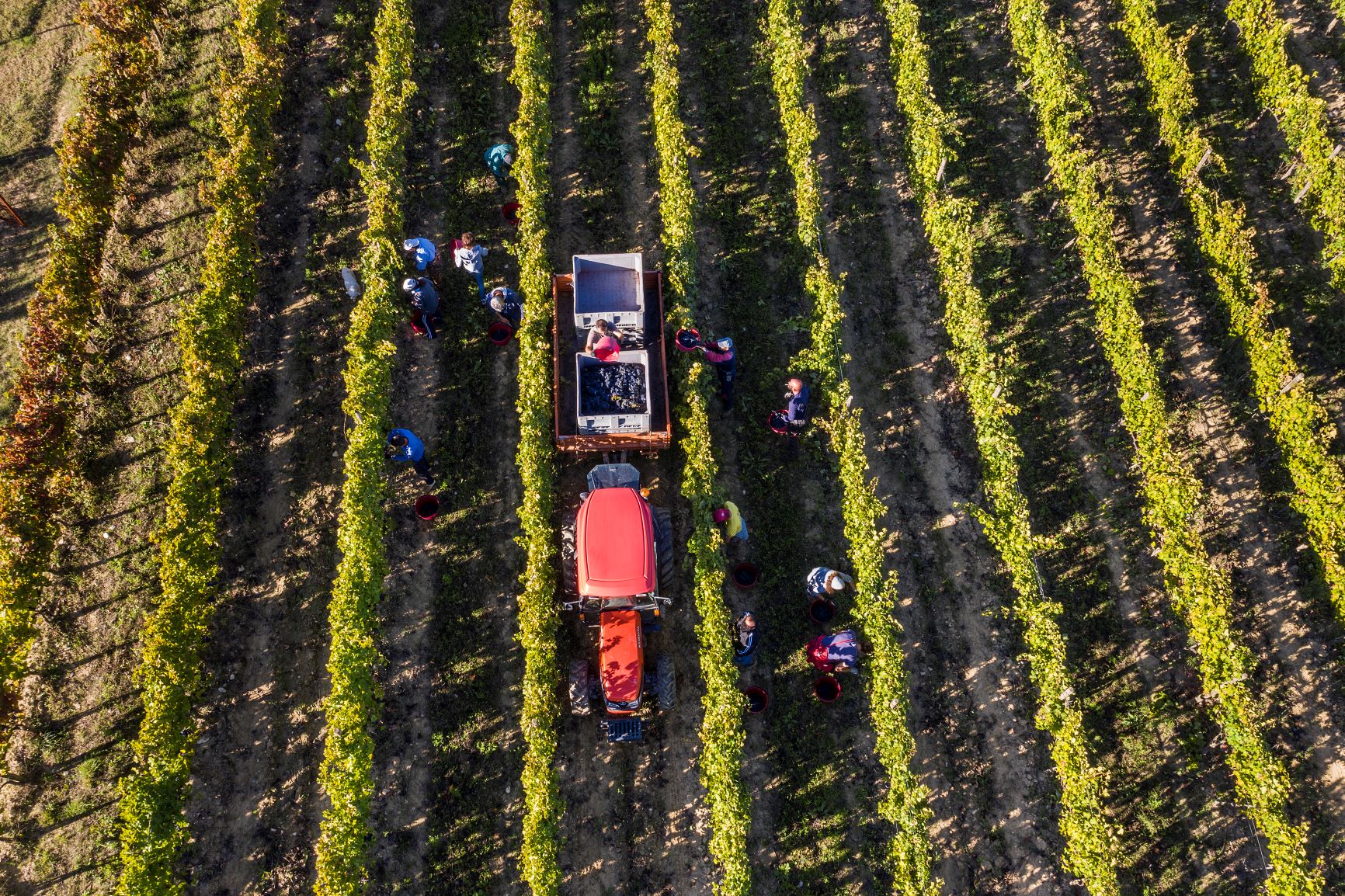 All hands on deck: the 2020 Brunello harvest at Montalcino’s Cinelli Colombini
All hands on deck: the 2020 Brunello harvest at Montalcino’s Cinelli Colombini
In Chianti, Castello di Monsanto began picking its Chardonnay grapes on 8th September, and collected its final Sangiovese on 10th October. Third-generation owner, Laura Bianchi, informed us that their spring was mild, with enough rain to create a “perfect” reserve of water for the vines. After the hot and dry August, a wet start to September helped to regulate maturation – a common theme throughout Tuscany in 2020. The grapes thus developed a “great balance of sugar, pH, and phenolic maturation”, and the first fermentation already suggests a vintage of “great personality, rich tannins, and beautiful acidity”. Further east, Vecchie Terre di Montefili started picking on 29th September – late in comparison to other producers, but normal, the team explains, for their vineyards, which lie 500 metres above sea level (and therefore require a longer maturation period).
Less than an hour away, Brancaia finished its harvest on 30th September (having started on the 3rd week of August). The team tells us that they were forced to harvest their Sangiovese quickly before heavy rain arrived, but that they were lucky that the grapes were “the perfect grade of ripeness”. In contrast, IPSUS owner, Giovanni Mazzei, explains that he and winemaker Gionata Pulignani decided to wait until after the extra rain in September before starting the harvest, “to guarantee more balance, extra aromatics, and temper the alcohol content”. In doing so, the hot and dry summer was counterbalanced; Mazzei states that he could indeed “classify the [2020] as a good compromise between cooler and hotter vintages”.
In coastal Maremma, owner and Production Manager at Fattoria Le Pupille, Ettore Rizzi, tells us that 2020 saw a significant threat of powdery mildew across its vines, especially in the thin-skinned varieties of Sangiovese, Ciliegiolo, and Syrah. He states that they nonetheless managed to trim the affected bunches and stem the problem, while their Merlot and Cabernet vines also “gave us some incredible fruit”. According to Rizzi, “the word that can best describe the 2020 vintage is concentration” – a consequence of the high temperatures in July and August.
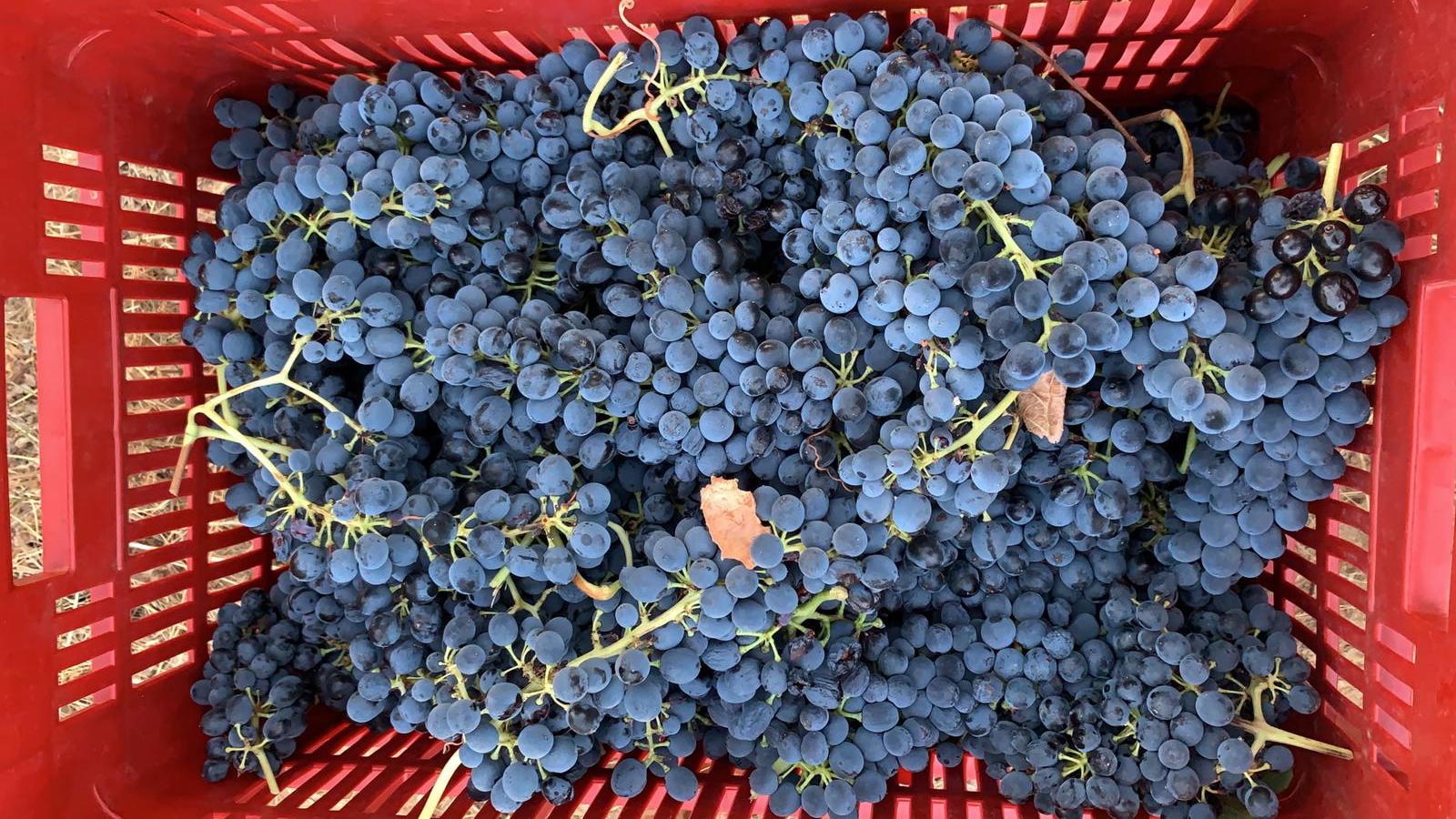 “The final quality of the grapes was really good” – Fattoria Le Pupille’s 2020 Syrah grapes
“The final quality of the grapes was really good” – Fattoria Le Pupille’s 2020 Syrah grapes
In Bolgheri, Ornellaia’s Estate Director, Axel Heinz, declared that their 2020 vintage is “shaping up to be one to remember as a great year”. The property saw “textbook perfect conditions until the end of May”, while June saw a lot of rainfall that “accelerated vine growth”, and required lots of work in the vineyard to keep the canopies under control. Summer saw hot and dry conditions, while rain arrived in the last days of August to alleviate drought stress and lower temperatures, encouraging a more even ripening at the last moment. While an unexpected mid-September heatwave made it necessary to pick all three red varieties – Cabernet Franc, Cabernet Sauvignon, and Petit Verdot – simultaneously at speed, Heinz notes that they nonetheless look “very promising in a rich and structured style”.
Moving up to Piedmont, fifth-generation of the esteemed Gaja family, Giovanni Gaja, tells us that they are so far “optimistic” about the 2020 vintage, despite it being early days to evaluate the exact character of the grapes. Their Barbaresco plots witnessed a moderate July, followed by a warm August that was similarly alleviated by rain towards the end of the month. While they required extra efforts to prevent mildew attacks, the final picked grapes appear “very healthy”.
While 2020 has caused much uncertainty, the recent harvest suggests that there is definitely hope for some excellent wine to come from this year, and we look forward to finding out for ourselves in the future.
If 2020 has given any gift at all, it would be time at home, which many have used to read more, and learn new things on topics familiar and foreign. Today’s blog helps you discover the unique stories behind some of the world’s most recognisable wines. Read on below to discover beyond the label of these notable names.
Krug – Cracking the code
Beyond its reputation as one of the most admired Champagne brands, Krug has also pioneered an industry innovation: Krug iD. Since 2011, a six-digit “identification code” has been printed on the back label of every Krug bottle. Scanning the code with a smartphone gives drinkers access to the unique story of the individual bottle, including a vintage report, as well as offering food pairing suggestions, and recommendations for its storage and serving.
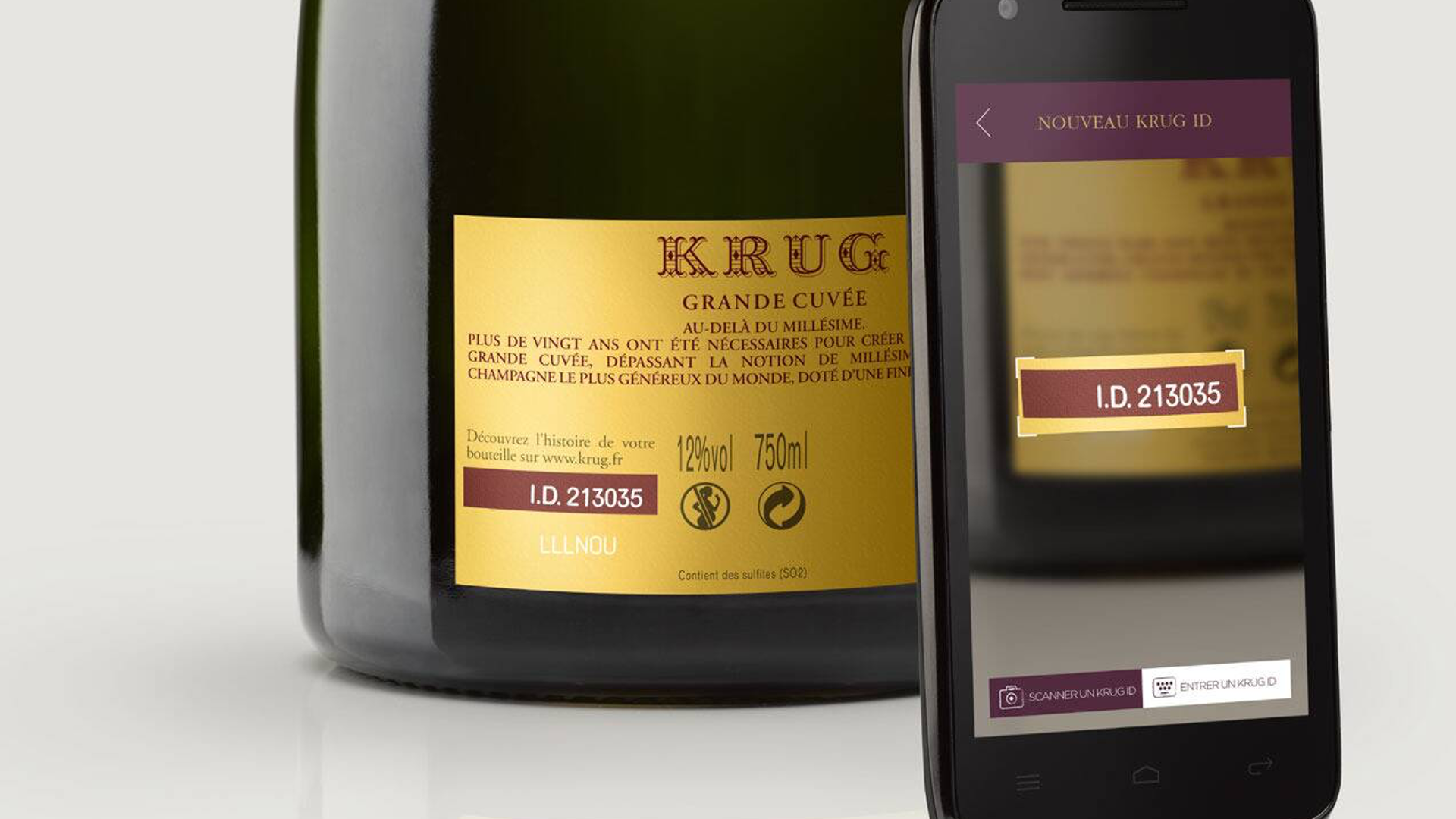 Photo credit: lvmh.com
Photo credit: lvmh.com
Aside from its technical innovation, the quality of Krug is simply undeniable. The latest NV Krug Brut Grand Cuvée (168ème Édition) achieves MUST BUY status, and receives a score of 19/20 from Wine Lister partner critic, Jancis Robinson, who notes a “remarkable acidity underpinned by great depth of flavour and beautiful balance on the finish”. It is available to purchase by the bottle from Crump, Richmond & Shaw Fine Wines for £133 (in-bond).
Cheval Blanc – Cultivation experimentation
Saint-Emilion superstar, Cheval Blanc, has illustrated significant long-term investment in its viticulture in recent years. Initiated by Managing Director, Pierre Lurton, the estate has conducted countless soil analyses, viticultural experiments, and regular phenological surveys to establish the best grape variety for each of its three different terroirs (gravel over clay, deep gravel, and sand over clay). Experiments have tested each possible variation of soil type for the Bordeaux varietals used in Cheval Blanc – 52% Cabernet Franc, 43% Merlot, and 5% Cabernet Sauvignon – to establish which combination delivers the best quality of fruit. Indeed, the château found its plot of sandy terroir to be particularly well suited to Cabernet Franc, providing a reference point for the best that can be achieved with the grape in Bordeaux.
Released en primeur in July this year, the 2019 Cheval Blanc was awarded 18 points from Jancis Robinson, who describes it as “beautifully poised on the palate with a density of fruit and silky texture of finely matted tannins. Pure, seductive and persistent”. It can be bought by the case of six for £2,400 (in-bond) from Farr Vintners.
Bond – Truth in terroir
With grapes sourced from select hillside plots across Napa Valley, Bond’s portfolio of Cabernet Sauvignon-based wines aims to reflect each wine’s specific sense of place. The estate owns five sites featuring some of the region’s best terroirs, and has dedicated its viticultural practice to preserving the best expression of its individual plots; Melbury, Pluribus, Quella, St. Eden, and Vecina.
The fruit from each site is vinified separately, while winemaking procedures are kept the same across all of the Bond wines in order to honour terroir differences. The Vecina vineyard, for instance, sits on volcanic soil at between 221 and 330 feet above sea level, causing a thermal amplitude of cool nights and hot afternoons, which renders its wines complex and layered, with concentrated tannins. The 2015 Bond Vecina was awarded 97 points from Wine Lister partner critic, Antonio Galloni (Vinous), who indeed describes it as “super-expressive. A big, dense wine, the 2015 possesses stunning richness and dimension”. It is available by the bottle for £443 (in-bond) from Fine+Rare Wines.
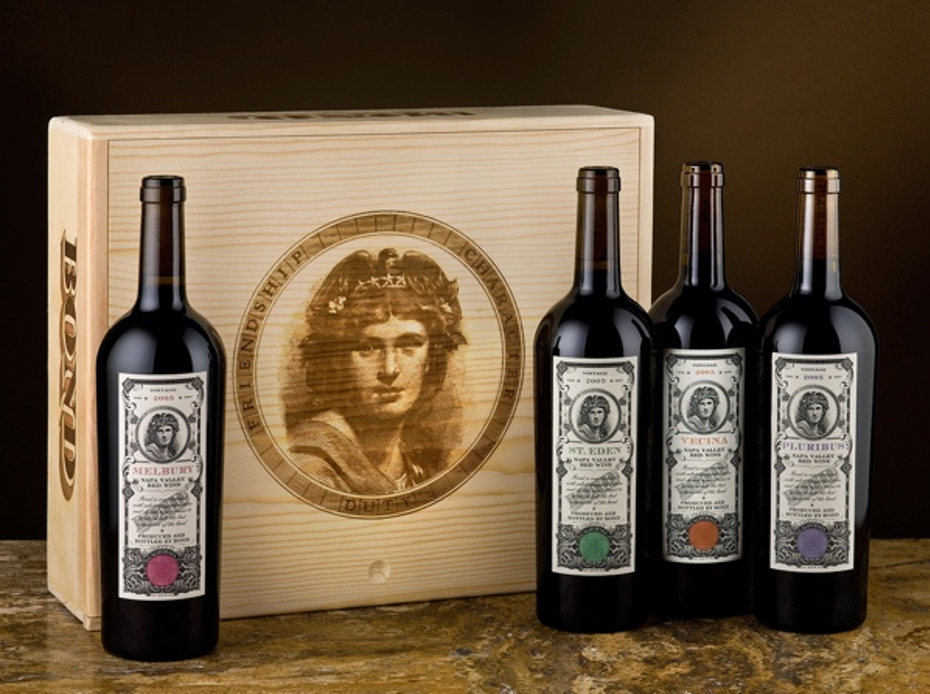 A line-up of Bond wines, that communicate the differences in the estate’s Napa Valley sites.
A line-up of Bond wines, that communicate the differences in the estate’s Napa Valley sites.
Ornellaia – An artist’s interpretation
Outside its global renown as a reference for quality in Tuscany, Ornellaia also stands out for its own special label tradition. Established in 2006, the estate’s annual artist program, Vendemmia d’Artista, commissions a new artist each year for the creation of the limited-edition label, inspired by a single word chosen by winemaker, Axel Heinz, to capture the essence of the new vintage. The latest release (2017) was named “Solare” due to the especially hot growing season, in which both the Cabernet Sauvignon and Cabernet Franc grapes were harvested as early as August for the first time in history. This inspired contemporary artist, Tomás Saraceno’s label design (below).
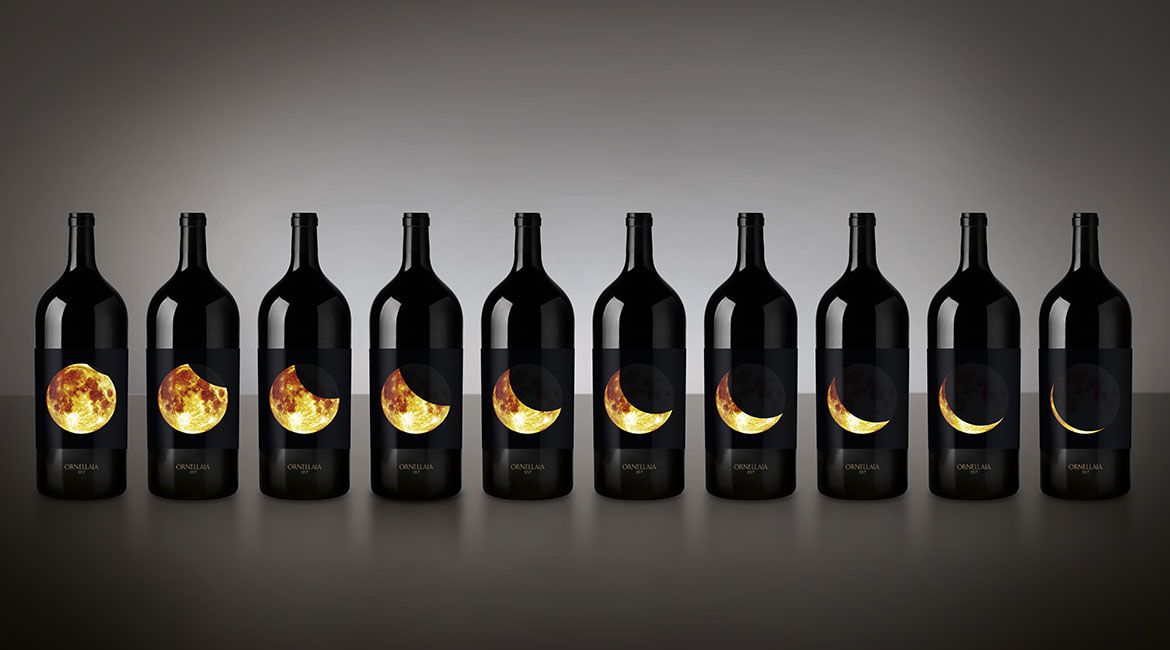 Photo credit: ornellaia.com
Photo credit: ornellaia.com
Awarding the Ornellaia 2017 97 points, Wine Lister partner critic, Antonio Galloni describes it as “sumptuous and racy, as Ornellaias from warmer years tend to be, but it is not at all heavy or overdone. In a word: superb!”. The vintage can be bought by the case of six from Justerini & Brooks for £765 (in-bond).
The four above-mentioned wineries provide just a small handful of innovative and engaging examples of how to make a wine stand out from the crowd. Wine Lister has launched a dedicated PR and communications service in order to help more producers do the same on the UK market. To find out more, please contact us at team@wine-lister.com.
Releases from two cult Californian producers have taken centre stage this week so far – see the analysis below.
Vérité 2017s
The 2017 vintage of the Vérité trio – La Muse, Le Désir, and La Joie – was released on Monday, at £320 per bottle each (in-bond). The latest releases have picked up much praise from critics, and mark an historic year for the estate – completing its harvest one week before the arrival of North California’s devastating Tubbs Fire, Vérité’s vineyards escaped unscathed, and their grapes picked before any smoke taint from neighbouring areas could set in. This also marks the first collective release of Vérité’s flagship wines in an assorted case, with previous vintages available to purchase separately.
Comprising 100% Merlot grapes for the first time since its conception, La Muse 2017 receives 96 points from Wine Lister partner critic, Antonio Galloni. He notes that the vintage “is aromatically deep, beautifully persistent and just impeccable in its balance”, stating that he “liked it more than the 2016”. A price of £320 places the 2017 20% below the current market price of the 2016, which has risen over 30% in price since its release, and has limited remaining market availability.
Le Désir 2017 obtains 98 points from Galloni – its highest ever score from the critic. He states it is “off the charts fabulous”, and describes notes of “mocha, chocolate, licorice, leather, menthol, pine and spice”. Akin to La Muse, market availability of last year’s release is scarce, illustrating its good track record of selling through post-release. Keeping in mind the 2017’s record-breaking score, it will be interesting to see if this trend continues this year, given the collective format in which the wines are being sold.
La Joie 2017 breaks the same record as its sibling, Le Désir, receiving its highest score to date from Galloni (96). He calls it “another gorgeous wine in this lineup”, describing “hints of rose petal, lavender, mint and blood orange”, and concluding that it is “a stunning wine by any measure”.
Joseph Phelps
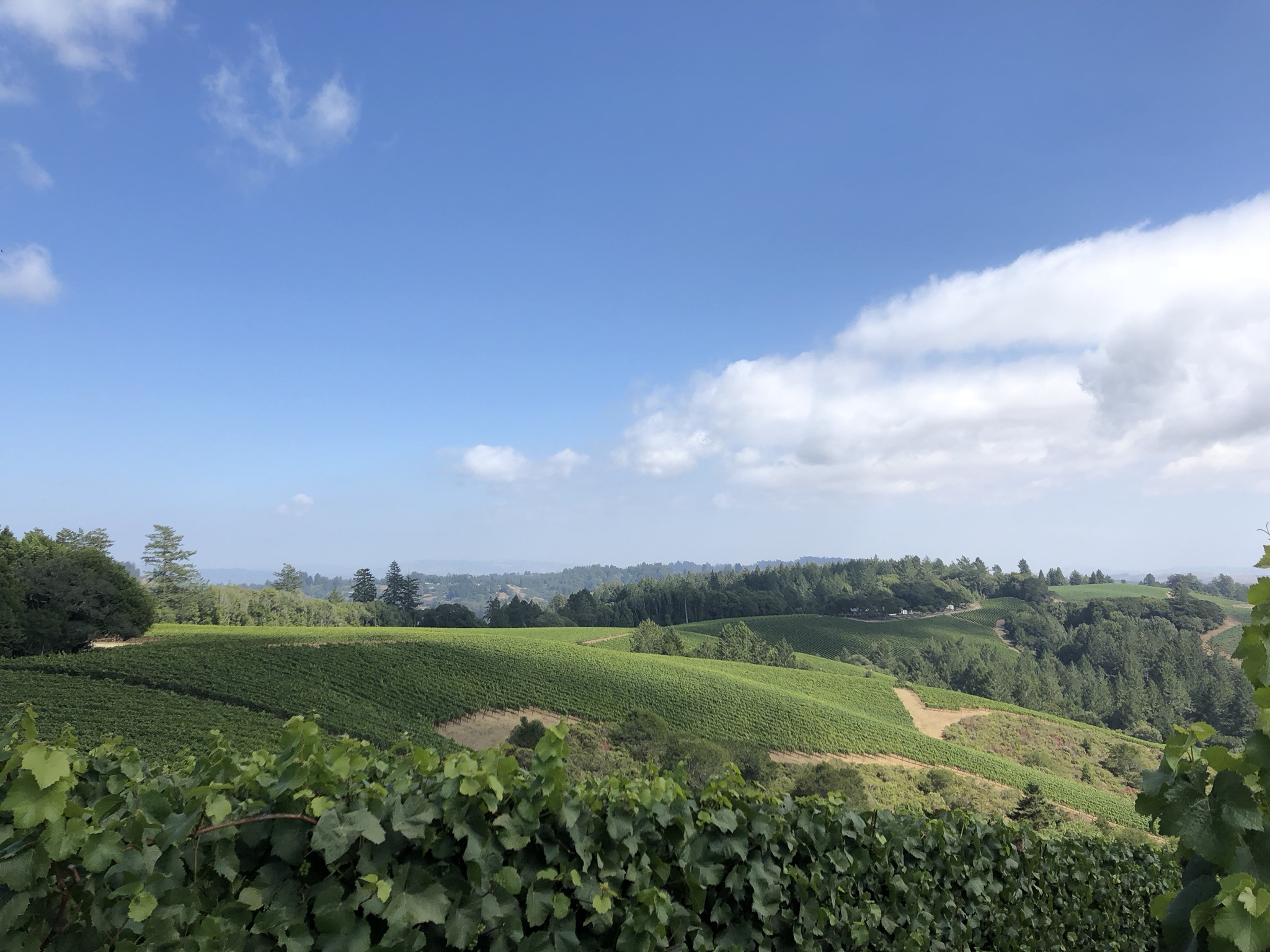 Joseph Phelps’ Napa Valley vineyards – which saw their hottest recorded temperatures in 2017
Joseph Phelps’ Napa Valley vineyards – which saw their hottest recorded temperatures in 2017
Insignia 2017 entered the market yesterday at £160 per bottle in-bond (flat on the 2016 release price). As we were told in a recent Zoom tasting with Phelps’ granddaughter and the winery’s Director of Business Development, Elizabeth Neuman, the 2017 vintage lives up to her vision of Insignia as “a tangible legacy of Joe himself – achieving the best of the best”. Neuman informed us of Winemaker, Ashley Hepworth’s recent dedication to achieving texture in the wine, through which she has experimented with blending trials prior to ageing.
Awarding Insignia 2017 91-94 points, Galloni indeed describes a “dark, sumptuous and enveloping feel, with a real sense of breadth and textural resonance”, adding that “more than anything else, the 2017 is all about palate richness”. Wine Lister likewise recognised the finessed texture of the vintage, with Wine Lister CEO, Ella Lister, calling it “supple, gentle, and silky” on the palate, complete with “dark fruit, plum, and chocolate” on the nose.
Frequent heatwaves in 2017 saw record-high temperatures reached throughout the growing season, including an instance of 46.7°C, recorded in Phelps’ Saint Helena Ranch during Labor Day weekend. The 2017 vintage is consequentially the winery’s smallest in 20 years, with total production down 60% on the 2016. The significant reduction in the volume released this year, as well as the estate’s developing style, may work to encourage interest.
Also released over the past two days: Orma 2018, Petrolo Galatrona 2018, and Siepi 2018.
Sign up to Wine Lister’s free subscription to get market insights delivered straight to your inbox: https://wine-lister.com/subscribe/info.
The Place de Bordeaux September releases commenced this week (Tuesday 1st September), launching the distribution of several New World (and a few Old World) icons through its impressive network. The releases have so far exhibited high praise from critics. This affirms the increasing appeal of New World wines, despite the current economic crisis making for an unlucky welcome.
Choices from Chile
Clos Apalta opened the stage on Tuesday, with a vintage that marks its 20th anniversary, as honoured by the 2017’s commemorative bottle. Receiving 100 points from James Suckling, and 95 points from Luis Gutiérrez for Wine Advocate, its average critics’ score of 97.5 matches both the 2016 and 2015 vintages. We sampled it at this week’s Bordeaux and Beyond tasting, organised by négociant CVBG, and found notes of bright red fruit, spice, and orange peel. Despite being one of the most expensive recent vintages (joint with 2016) at £74.50 per bottle (in-bond), Clos Apalta has no doubt achieved a high quality for this anniversary bottle.
Another Chilean entry, Almaviva 2018 was released at £101.00 per bottle (in-bond) on Wednesday (2nd September) – c.4% down on last year. Its average critics’ score of 97 points places it in line with 2017 as the joint-best average score to date, which, alongside its slight reduction in volume from last year, may stimulate demand. Indeed, we found the 2018 to be bright and energetic, with notes of ripe currants, green tomato, and spice.
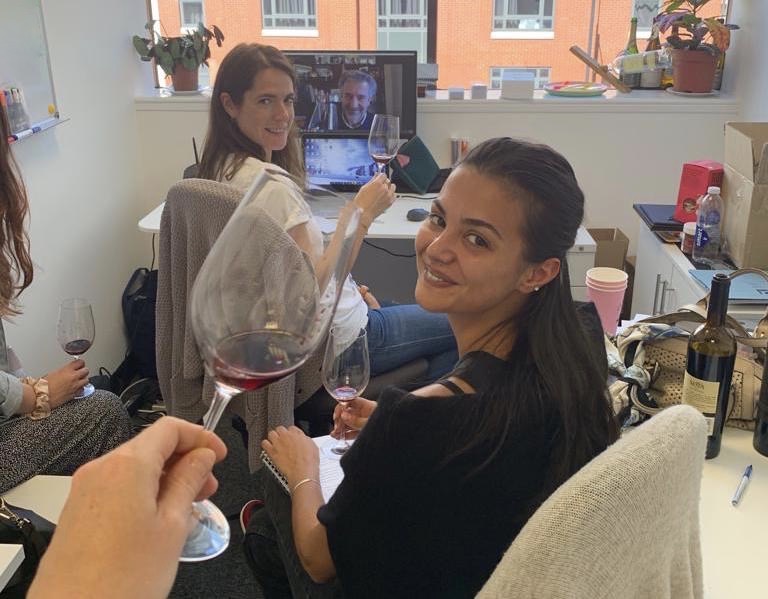 The Wine Lister team sample 2018s from Seña and Chadwick with Owner, Eduardo Chadwick, and his team
The Wine Lister team sample 2018s from Seña and Chadwick with Owner, Eduardo Chadwick, and his team
Released on Thursday (3rd September) at £82.50 per bottle (in-bond), Seña 2018 is “the best vintage of this decade”, according to Owner, Eduardo Chadwick. He explained to us that growing conditions in 2018 were balanced between the two previous vintages (2016 was very cool, while 2017 was hot and dry), creating “almost a perfect season”. The vintage receives 100 points from James Suckling, and 98 points from Luis Gutiérrez for Wine Advocate, making it Seña’s highest-ever average score from those two critics – 99. Our team was equally impressed in our virtual tasting, noting its velvet mouthfeel, silky tannins, and juicy freshness. Chadwick 2018 was also released this week (just 6000 bottles), acquiring an average critics’ score of 97.5 at £226.33 per bottle (in-bond).
Introducing Italy
Bibi Graetz Testamatta 2018 and Bibi Graetz Colore 2018 entered the market on Tuesday (1st September), at £70 and £180 per bottle (in-bond), respectively. Both wines offer significant discounts from their previous releases, and have achieved praise from critics. James Suckling gives 97 points to Testamatta 2018, describing a “cherry and lemon rind character”, and “fine tannins”, and 100 points to Colore 2018, calling it “one of the best vintages ever produced. The high quality and suitable pricing of both wines will likely be embraced in the present economic climate.
An Australian addition
Jim Barry The Armagh Shiraz 2016 entered the market on Wednesday, at c.£151 per bottle (in-bond), marking the producer’s inaugural release through La Place de Bordeaux. The vintage received 97 points from Wine Advocate’s Joe Czerwinski – the highest WA score received by The Armagh Shiraz since its 2012 vintage. He states that the 2016 is “full-bodied and supple” and “finishes cedary, intense and long, adding in complex, lingering spice notes”.
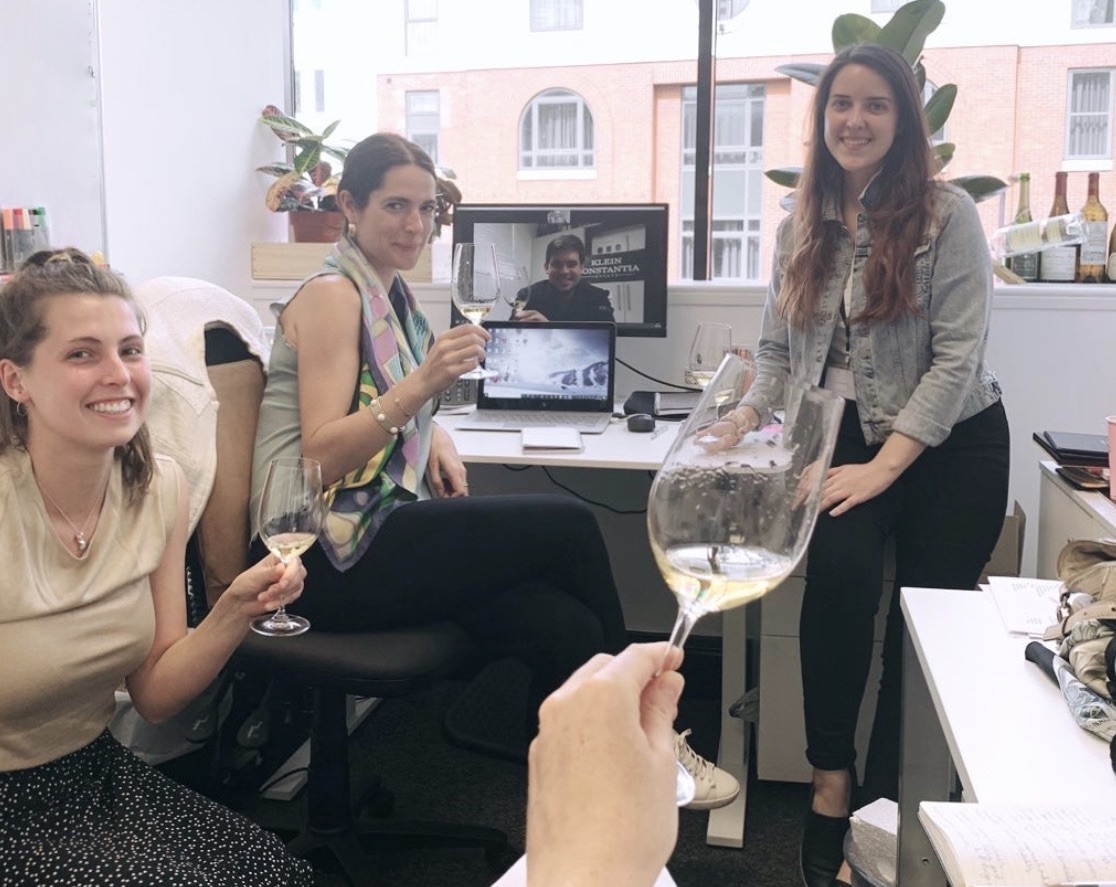 The Wine Lister team sample the 2017 Vin de Constance with Winemaker, Matt Day
The Wine Lister team sample the 2017 Vin de Constance with Winemaker, Matt Day
A sweeter offering from South Africa
As told to us by Winemaker, Matt Day, in a recent Zoom tasting, the 2017 Vin de Constance (released on Wednesday 2nd September) is the closest vintage yet to their philosophy of creating a “dry sweet wine”. Wine Lister’s CEO, Ella Lister, notes hints of “apricots, rosewater, lemon balm, Marcona almonds, and acacia honey” among other aromas, and on the palate “dried apricots and a gorgeous savoury finish”. At £39 per bottle (in-bond), the 2017 receives 97 points from James Suckling, compared to an average of 95 (from James Suckling and Wine Advocate) for each of the past three years. While it does not offer a discount, Klein Constantia does a spectacular job of achieving high quality in its developing style of Vin de Constance.
Kick-starting California
L’Aventure Estate Cuvée 2018 was released yesterday (Thursday 3rd September) at c.£68 per bottle (in-bond) – flat on the 2017 release price, and earning 95 points from Wine Advocate’s Erin Brooks (one down from the 2017). She noted that “the full-bodied palate is incredibly pixelated and silky with very bold freshness and a long, layered finish” and that she “can’t wait to taste this beauty from bottle”. We enjoyed detecting violet, toast, and vanilla on the nose, and were similarly impressed by its velvet mouthfeel.
Among other benefits available exclusively to the trade, Wine Lister’s Pro+ Subscription offers real-time release alerts and live analysis on major wine releases throughout the vinous calendar. Please email us at team@wine-lister.com to enquire.
As en primeur 2018 picks up pace, we consider the 10 Bordeaux wines that any fine wine collector should acquire for their collection. These are based on the results of Wine Lister’s latest Founding Member survey, gathering the views of over 50 key players in the global fine wine trade.
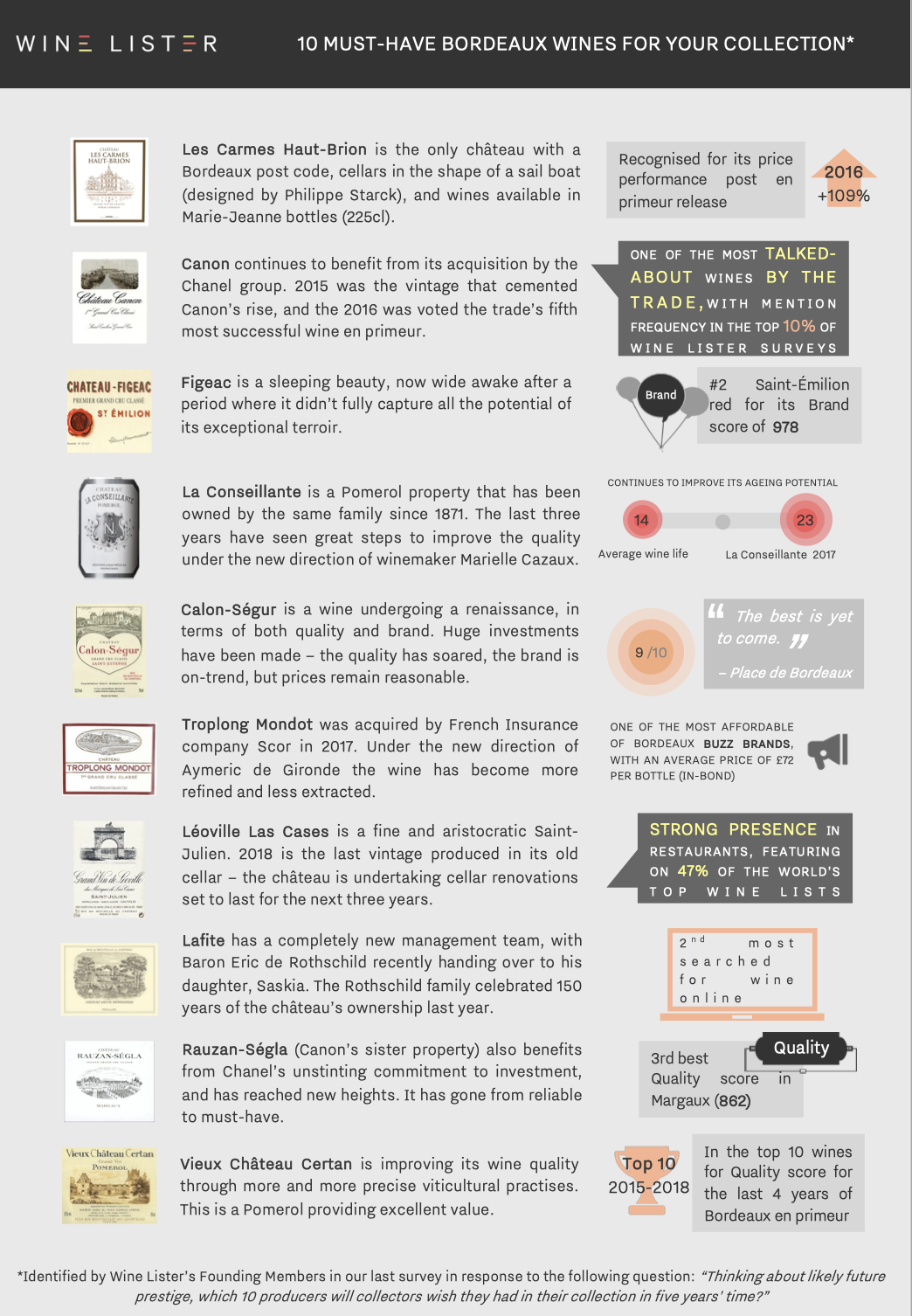
You can download this slide here: 10 must have Bordeaux wines for your collection
At the end of last year, Wine Lister released its first ever Champagne report. As well as exploring a handful of key trends as identified by Wine Lister’s Founding Members, the report also sheds light on top Champagnes as compared to other regions in terms of economic performance.
Prices of the top Champagnes (Dom Pérignon, Krug Vintage, Louis Roederer Cristal, Salon Le Mesnil and Dom Pérignon Rosé) have seen a compound annual growth rate (CAGR) of 4.8% over the last six years. Relative to other major fine wine regions, this long-term growth is slow, as shown in the chart below, but also stable.

One notable advantage of Champagne as an investment option it its low volatility. Indeed, Champagne prices show a much better level of stability in the secondary market (deviating by just 2.5% from the average price over 12 months) than any other major fine wine region. Slow and steady wins the race.

Moreover, recent price performance shows Champagne accelerating. Prices of top Champagnes are starting to grow at a faster rate than their counterparts in California, Bordeaux, and Tuscany, beaten only by Piedmont and the seemingly unmatchable Burgundy. Indeed, as of December 2018 top Champagnes had seen a 12-month price growth of 11%. The region’s potential for long-term investment is already being acknowledged by the trade, with one of our Founding Members, a top tier UK merchant commenting “Champagne (Salon especially) has experienced solid growth and has become a reliable investment for collectors”.
Salon Le Mesnil is the number one performing Champagne for price performance, with an Economics score of 978, closely followed by Krug’s Clos d’Ambonnay (962). Krug also tops the Champagne Economics charts with its Clos du Mesnil, Brut Vintage, and Collection. Interestingly the only NV Champagne to appear within the top 10 Champagnes for Economics is grower Jacques Selosse’s Brut Initial, with an Economics score of 911. Its price, £106 (per bottle in-bond), is a mere 18% of the average price of the other nine top Champagnes by Economics score.
To read more key findings from our in-depth Champagne study, read the free summary here. (The key findings and full study are also available to download in French on the Analysis page.)
With the first major set of releases for 2019 in full swing (Burgundy 2017), the Wine Lister team are already looking ahead for what else is in store for wine collectors and trade members alike. In February we expect to see the release of Barolo 2015s – set to be a more concentrated and riper vintage than the previous due to high temperatures throughout the summer. In anticipation of these, Wine Lister is examining the top five Piedmont Buzz Brands by Brand score.
Ironically, the highest-scoring brand of this week’s top five is in fact not a Barolo at all. Gaja’s Barbaresco takes the top spot with a Brand score of 975. Wine Lister partner critic Antonio Galloni gives the 2014 vintage 96 points, and comments, “this is one of the most tightly wound, intense versions of Gaja’s Barbaresco I can remember tasting. Don’t miss it”.
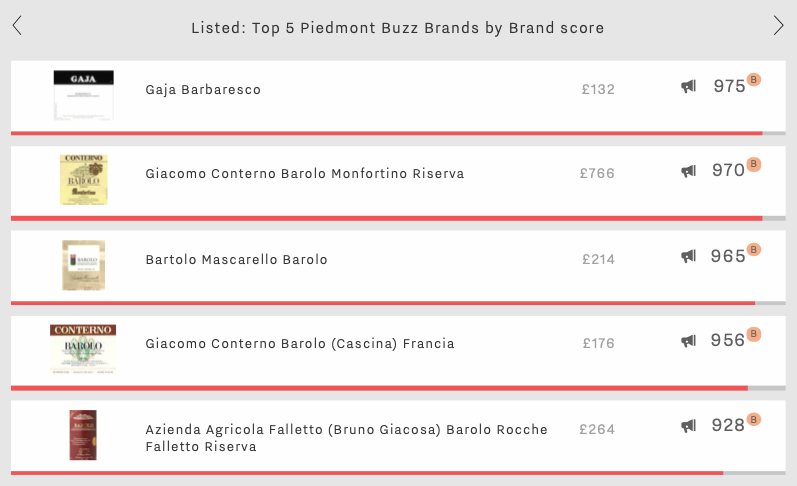
While it is no longer breaking news to see such high quality Barbaresco emerging from under Barolo’s shadow, the making of such a well-recognised brand is impressive. This is achieved by presence in 31% of the world’s best restaurants, and a search rank of 76 out of the c.4,000+ wines on Wine Lister. Gaja’s single vineyard Barbarescos, Sorì San Lorenzo, Sorì Tildin, and Costa Russi are also popular with an average Brand score of 915.
In second place for top Piedmont Buzz Brands is Giacomo Conterno’s Barolo Monfortino Riserva. Sitting just outside the top 50 most-searched-for wines (in 51stplace), it is both the highest quality and the most expensive wine of this week’s top five, with a Quality score of 977, and an in-bond per bottle price of £766. The price tag, which is just under four times higher than the average price of the other four wines of this week’s group, is perhaps due to the tiny production quantities of just c.7,000 bottles per year.
Giacomo Conterno also takes a second spot in this week’s top five – fourth place, with his Barolo Cascina Francia, which earns a Brand score of 956 and a Quality score of 960. Despite score gaps between these two wines of a mere 14 and 17 points respectively, an average of three times as many bottles are produced of Cascina Francia than its grander (and much rarer) sibling. It is available at just 23% of the price of the Barolo Monfortino Riserva – £176 per bottle in-bond.
In third place of this week’s top five is Bartolo Mascarello’s Barolo with a Brand score of 965. While its scores across the board sit in the mid-range of this week’s top five, it achieves the best long-term price performance, with a three-year compound annual growth rate (CAGR) of 34.7%.
Lastly, at number five of this week’s group is Bruno Giacosa’s Barolo Rocche Falletto Riserva with a Brand score of 928. Although the Barolo Rocche Falletto Riserva has the lowest search rank of this week’s top five (158th), online searches for this wine saw impressive increases last year (read more here). It achieves a Quality score of 974 – just two points under the best Quality performer of the group (Conterno’s Barolo Monfortino Riserva). Indeed at vintage level these two wines share a near-perfect Quality score of 998 for their respective 2004 vintages, both earning 100/100 from Antonio Galloni.
It is interesting to note the high quality that accompanies these top Piedmont Buzz Brands (an average Brand score of 959 vs. 945 for Quality). The disparity between scores is more accentuated for the equivalent group in Tuscany, which achieves a Brand score of 991 for a Quality score of 932, or in other words, a 59-point gap.
At the beginning of this new year, Wine Lister is prolonging the festive sparkle through a look at the major trends to emerge from our first Champagne report. Wine Lister’s Champagne study analyses a basket of 109 top wines from the world’s premier sparkling region, and includes insight into the major trends of the Champagne market as identified by Wine Lister Founding Members (c.50 key players in the international fine wine trade).
While quality across the board is something to keep us celebrating well in to 2019 (see more on this here), the notable trends could indicate an increase in year-round enjoyment of Champagne. The chart below shows responses to our question, “What are the most important trends in Champagne?” by number of votes.
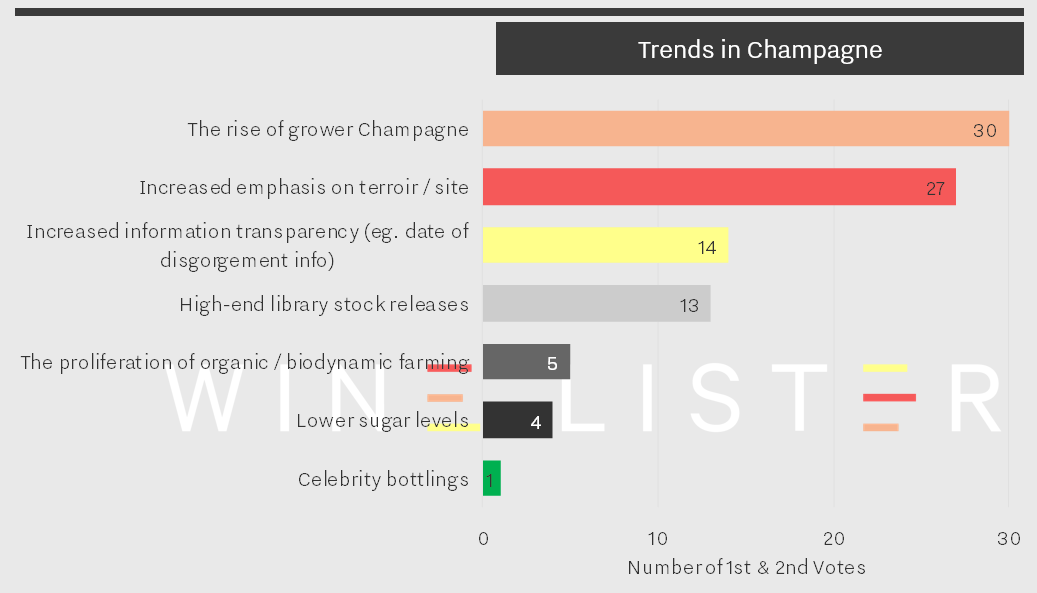
The trend most-frequently ranked as number one or two by Wine Lister Founding Members was the rise of grower Champagnes, closely followed by the increased emphasis on terroir / site Champagnes. One U.K. merchant remarked that “Consumers are now identifying with specific terroir in Champagne and understanding the value of the grower…” – a comment that further leads us to suspect an increased appreciation of Champagnes as wines, and not just celebratory bubbles.
The “rise of the grower” trend is, however, juxtaposed by continued demand for big brands. Of the basket of wines treated in the study, the grower Champagne segment has seen an increase in popularity (measured by search rank) of 9% since the beginning of 2017. Though this performance is superior to the maison segment’s slight decline in popularity (-4%), grower Champagnes still sit twice as far down the popularity rankings, with an average search rank of 1,620 compared to 775.
Perhaps predictably, big brands still win the race when it comes down to the bottom line. A U.K. merchant commented, “Small growers are getting much better press, but I suspect the big name cuvées still rule the roost for sales/investment”. Indeed, when asked to award confidence ratings to specific Champagne producers, the trade cited only one grower champagne within the top two confidence scores (9/10 and 8/10), Jacques Selosse. The houses to earn top confidence ratings were Dom Pérignon, Krug, Louis Roederer, Salon, Bollinger, Pol Roger, and Taittinger, as shown on the chart below.
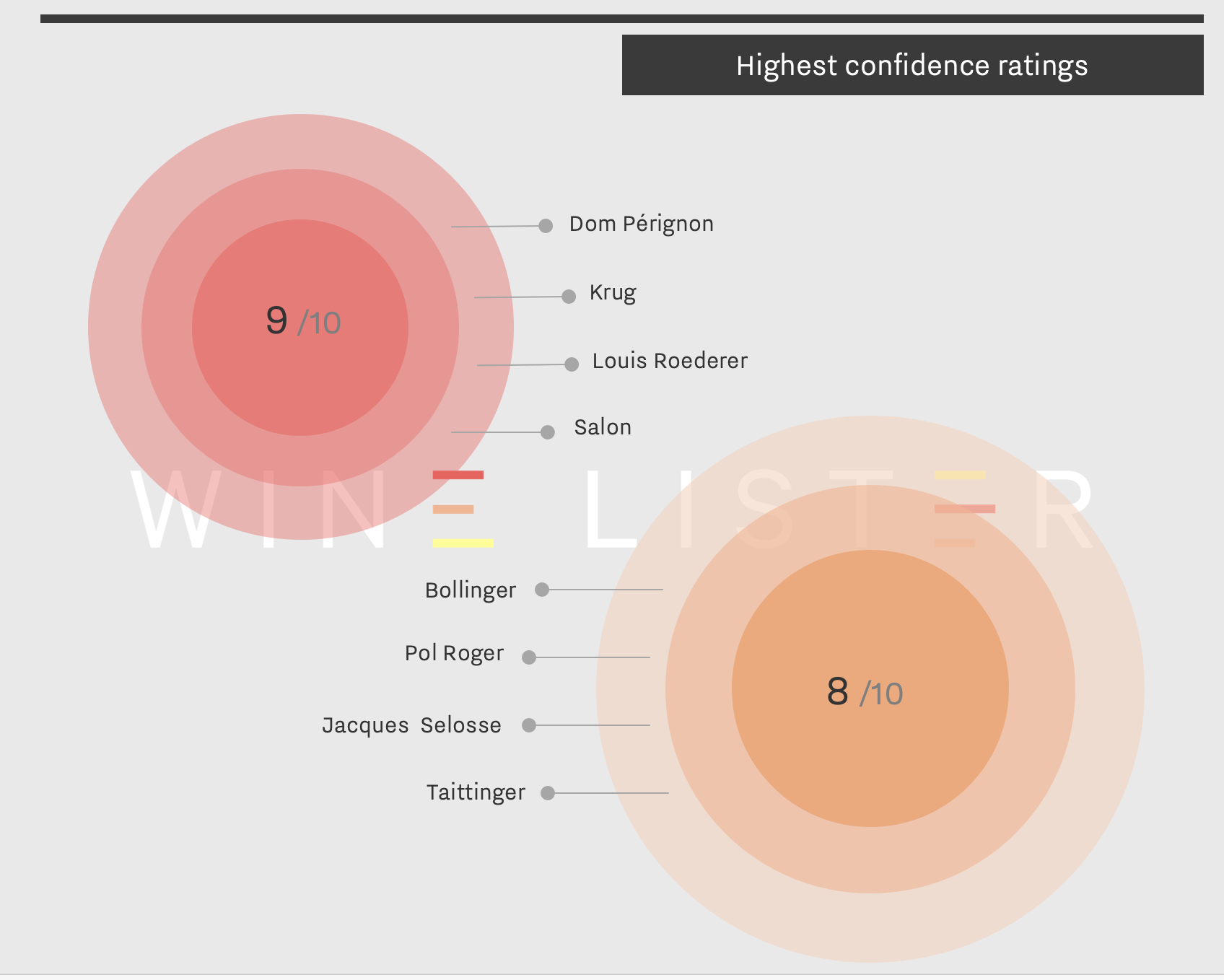
A top tier merchant offers some explanation into the difference in picture painted between the top Champagne trend and Champagne confidence ratings: “Production needs to be small but not so small as to result in a proliferation of Champagnes which the vast majority have never heard of. The big brands which produce great quality are still finding serious demand in the market!”
For a more in-depth look at Champagne, subscribe or log-into read the full report here. Alternatively, all readers can access a five-page executive summary. (Both versions are also available to download in French).




 Photo credit: lvmh.com
Photo credit: lvmh.com A line-up of Bond wines, that communicate the differences in the estate’s Napa Valley sites.
A line-up of Bond wines, that communicate the differences in the estate’s Napa Valley sites. Photo credit: ornellaia.com
Photo credit: ornellaia.com







